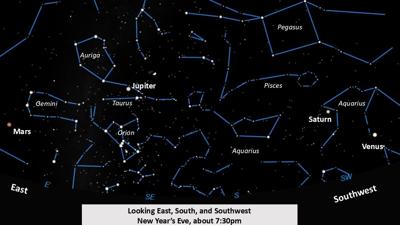Welcome to December. The last month of the year normally does not present many clear skies in our part of the country, but we get some great skies to view when they do.
Earth’s Moon enters December just after its new Moon state. The Moon was new on the last day of November at about 10:30 p.m., so we barely miss having two new Moons in the same month. Full Moon comes on the 15th. On the 4th, the thin crescent Moon will be located just to the left of Venus after sunset, which should make for a great view.
The Moon passes Saturn on the evenings of Dec. 7-8. The Moon will pass in front of the star cluster Pleiades on the 13th, but it will occur during daylight here.
The planets truly take center in December, with every major planet except Mercury in the evening sky. Venus was visible very low in the west in November and it moving higher into the night sky in December, making it easier to see. Venus is unmistakable, a bright beacon in the western sky. Venus is bright enough to see with the naked eye in daylight.
Saturn is lower in the southwestern sky, but still easily visible in December. Located in the dim constellation Aquarius, Saturn stands out as brighter than any nearby star.
Jupiter, the solar system’s giant, will make its closest approach to Earth (“Opposition”) on Dec. 7. Look for Jupiter in the eastern sky, in the constellation Taurus, just to the left of the bright star Aldebaran.
Noticeably reddish Mars enters the December sky after about 9 p.m. early in the month. Mars will grow brighter during December, as it grows closer to us. Mars’ opposition will come in mid-January. Look for Mars in the constellation Cancer, just below the twin stars of Gemini, Castor and Pollux.
The solar system’s two outer planets, Uranus and Neptune, are also in the night sky, although difficult to see. Uranus is located in the constellation Taurus, to the right of the bright star cluster Pleiades. Uranus is bright enough to see with the naked eye under clear, dark skies, but is difficult to tell from nearby stars, requiring a telescope to locate it. Neptune is even fainter than Uranus, and also requires a telescope to locate. Our two outer planets are distant! Uranus is about twice as far away from us as Saturn, and Neptune is much farther, about 2.7 billion miles from us. Neptune takes about 165 years to orbit the Sun.
The Geminid meteor shower peaks on the night of Dec. 13-14. The Geminids are one of the best showers in the year, but a nearly full Moon will make them difficult to see this year.
Here is something to try during the Holiday season, assuming we get some clear skies. Find an open area, with good visibility of both the east and west horizons. Look at about 7:30 p.m. In the southwest, find both Venus and Saturn. High in the southeast, locate bright Jupiter. And low in the east-northeast, find reddish Mars. Other than little Mercury, you will have seen all of the naked-eye visible planets in our sky. Take the time to marvel at the bright constellations of winter rising in the east … Orion, Taurus, and Auriga. Find the square of Pegasus riding high above Saturn. Use the picture with this article for help in locating stars and planets.
Most of all, enjoy the night sky and happy Holidays!























Commented
Sorry, there are no recent results for popular commented articles.